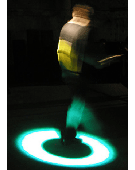Critic Edward Shanken once argued that artists have a 'responsibility to envision alternative futures... and shape the way people think, live, and interact.' The creators of 'When Ghosts Will Die,' took this call to action to heart. This interactive installation by Steve Gibson, Dene Grigar, Will Bauer, Jim Andrews, and John Barber creates a context in which visitors piece together a narrative about nuclear proliferation, effectively corroborating the artists' protest. The project was inspired by Michael Frayn's play, 'Copenhagen,' which centers on similar issues and draws on non-verbal devices in addressing them. In the case of 'When Ghosts Will Die,' performers don hand-held devices while navigating a space designed to evoke the virtual mise-en-scene of 'three potential phases of nuclear proliferation: 1) Disharmony, 2) Destruction, and 3) Disintegration.' These phases, each with their own spatial, visual, and auditory qualities, in the installation, are pieced together and experienced differently by each participant, so that the work then makes strides in both real-time processing and navigational narration. The artists say that the 'story is meant to shock those participating into a deeper awareness of the horrors of nuclear warfare.' They also claim that 'the development and deployment of weapons of mass destruction not only test a country's power but also its humanity,' an argument mirrored in their endowment of individual users with great decision-making power--or obligations. The artists recently released a DVD version of the project, which brings their otherwise site-specific message to your television. - Marisa Olson
